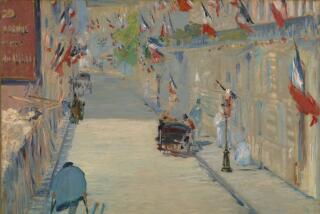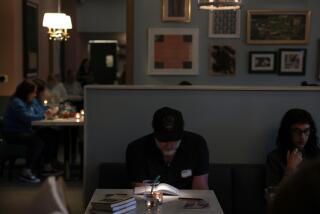Immutable Feast : THE CONTINUAL PILGRIMAGE: American Writers in Paris, 1944-1960. <i> By Christopher Sawyer-Laucanno (Grove Weidenfeld: $22.50; 320 pp.)</i>
- Share via
They were all there, right after the war, and Christopher Sawyer-Laucanno, coming very close to the truth, tells us why.
Some were escaping America: Richard Wright and James Baldwin and Chester Himes; even Harry Mathews, a WASP who found his fellow WASPs “extremely hostile to the poetic and artistic enthusiasms.”
Some, like Irwin Shaw and James Jones, had come to walk in the footsteps of their literary forebears. “No artist could consider himself fully prepared for his life-work without eating a croissant for breakfast or having a fine at the Dome,” said Shaw, in homage to the allegedly Lost Generation. Jones went him one better: “I walk the streets with Stendahl, Proust, Rousseau and Voltaire. . . . I feel lost in the primeval forest among the columns of Notre Dame. I get goose pimples just looking at the scene.”
Some, like poet/novelist Mathews and John Ashbery, came to soak themselves in what they felt was a superior culture; others--Allen Ginsberg, William Burroughs, Gregory Corso, Brion Gysin and the other unfettered inmates of the “Beat Hotel” that had no name--found the city “a vast playground.”
The writers came to Paris, as everyone must, to get what they needed: freedom, inspiration, respect, or just that piquant otherness that accrues from sitting at a cafe on boulevard St. Germain and entertaining the notion that one is at the center of the world.
“We feel particularly at ease for a change,” said William Styron, who also was there. “We know where we are and we wish to stick around.” Himes, even in his darkest days, “felt that I was left alone to become whatever I wanted to become. . . . Even when I was starving it was me starving, not a black man starving.” Baldwin felt released “from the necessity of apologizing.”
Jones marveled that “the artist has got some sort of honor here,” an honor Gertrude Stein could taste, literally: Returning to Paris immediately after the war, she was allowed to jump the queue at the meat market when the butcher bellowed, “Let her through! She’s a writer !” Of course it was Stein--whose tenure spanned the generations--who had the last, elliptical word: “It’s not so much what Paris gives you as what it doesn’t take away.”
Sawyer-Laucanno strives mightily to take nothing from his resplendent cast, but he is occasionally overwhelmed. How to grasp, in a chapter, the agony of Richard Wright--lionized by the Parisians, embraced by the existentialists--as the rasping truth of innate French racism begins to penetrate? How to pierce, in a chapter, the carapace of James Jones, of whom George Whitman, the many-splendored housefather/ bookseller, said: “He was affable--absolutely--but always underneath one felt that he wanted to be back fighting in the Pacific”? How to explicate what Ginsberg called “the psychic structure” of Burroughs’ “The Naked Lunch,” or the “highly permutated verbal construct” (the author’s words) of John Ashbery?
By design, these are sketches, not portraits. As such, they are useful in grouping and probing one particular wave of expatriate Yanks. As a quick tour, the book may help persuade another generation to tarry a while under the chestnut trees.
As “The Continual Pilgrimage” implies, the time to go to Paris is now. Always has been.
More to Read
Sign up for our Book Club newsletter
Get the latest news, events and more from the Los Angeles Times Book Club, and help us get L.A. reading and talking.
You may occasionally receive promotional content from the Los Angeles Times.







